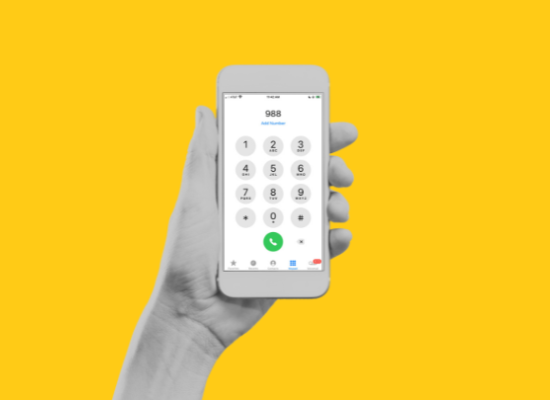
Stephanie Hepburn is a writer in New Orleans. She is the editor in chief of #CrisisTalk. You can reach her at .
There are police departments throughout the United States that no longer answer calls they believe could result in “suicide by cop.” Around 100 shootings like this happen each year, making up roughly 10% of fatal police shootings. Ron Bruno, a retired Utah police officer and CEO of Crisis Response Programs and Training, says this is a philosophy taking hold in law enforcement agencies all over the country, but he quickly points out, people can’t just be left in distress. “Something has to be done, and that’s why we need to examine our crisis response system as a whole, carving out clear roles for law enforcement and mental health services.” Bruno says that law enforcement has a critical part to play in the mental health crisis response system, but it needs to be in a position of support to the mental healthcare system and only when necessary. “We have to challenge the belief that mental health crisis services must come in a police car.”
While there are law enforcement agencies selectively unresponsive to some mental health calls, others are doubling down on their involvement. The impetus, says Bruno, is that, historically, mental health services haven’t been appropriately funded, and so law enforcement became the de facto mental health crisis response system. “It fell to us, but we aren’t the best solution or help to a person in an escalated state.” Bruno travels around the world, speaking to audiences on de-escalation and advocating for clearly defined roles for criminal justice and behavioral health services to create a more effective crisis response system. At some point during a presentation, he often asks the audience to raise their hand if they’ve ever been pulled over by a police officer. Most of the hands raise. Then, he’ll instruct them to keep their hands up if the experience increased their anxiety level. Hands remain raised. “Every time a police officer goes out to a crisis situation, it’s going to escalate the person’s emotional state. Yes, we can and will train officers to de-escalate situations, but often, their mere presence is stressful, and the person in crisis can become fearful and enter flight or fight. That’s when we see major problems.”
Estimates suggest that 25-50% of fatal encounters with law enforcement involve a person experiencing mental illness. Bruno says that in most cases, the interaction between law enforcement and the person in crisis is unnecessary. Just like audiences raised their hands to indicate the distress they felt when pulled over by a police officer, in de-escalation training, officers share that, in the majority of cases where they were called out, the situation didn’t warrant it. Bruno says having law enforcement be the go-to for mental health crisis care appears and feels criminalizing to the person in need. “Most departments have a policy that the person in crisis will be handcuffed, placed in the back of a caged police vehicle, and taken to an ER. This is traumatizing for the person and will make it so that they are reluctant to call for help the next time they are in crisis.” The result is that people in distress, and their families, allow further decompensation than they should before reaching out for help because they don’t want to interact with law enforcement. “With officers declining calls and people not wanting to interface with law enforcement when they or a family member is in crisis, it highlights that something is wrong with the current system.”
The solution, says Bruno, isn’t complicated (see image below). When a call goes into the Emergency Communication Center—911 dispatch—operators can be trained to triage those calls and identify whether the person in crisis is a danger to her or himself or an immediate threat to someone else. If not, then the person can be passed along to appropriate care in the mental health crisis system through a warm handoff to the crisis line. At that point, says Bruno, the crisis line can also do a secondary triage and determine whether it’s still a safe situation. If they decide that it’s unsafe, Bruno says they can do a warm handoff back to law enforcement, and law enforcement can send out Crisis Intervention Team (CIT) trained officers to go out and respond to those situations. “Most calls that go through 911 don’t require a law enforcement response and can be transferred to a crisis line where we know the majority of calls, 80% and upward, are resolved at that level, and there’s no need for police involvement.” (Bruno is the former executive director of CIT International.)

If an officer on the street comes across a person in crisis and assesses that the person is safe, she or he should reach out to mobile crisis. The challenge is that each community is unique, and many don’t have a robust continuum of crisis care. Bruno says that’s why each community needs to take a hard (and holistic) look at what’s happening in their public mental health system, addressing potential funding and geographical challenges. Ironically, says Bruno, many communities are defaulting to the least economical solution, using law enforcement as the primary form of mental health crisis services or embedded co-responder models, where law enforcement agencies dedicate personnel and partner them with clinicians to respond. “It’s expensive because now you have dedicated law enforcement officers waiting around for mental health crisis calls or, in some agencies, a clinician rides around with a police officer who is handling unrelated calls.”
Bruno says it’s time for public mental health to return to the community and allow people in crisis to be treated within it, instead of removing them from their support systems by taking them out of their day-to-day lives and roles. “It’s easier for people to transition back into their lives if they’re never fully yanked out of them in the first place and can be treated in the community.” He says retraining people to call a crisis line instead of 911 allows those in crisis to be treated in the least intrusive manner as opposed to the highest. “We’ve trained people to think that if a loved one is in crisis, they need to contact law enforcement, who will come out and take the person into protective custody. He or she will be handcuffed, put in the back of the police car, and taken to the ER. That’s what we’ve told people is the cost of stabilization.” He says it’s a grueling, stress-inducing process, that, more often than not, was unnecessary. A crisis line can help decrease a person’s distress, and if they are unable to, they can send out a clinician and certified peer specialist to talk to the person, and, when necessary, the support of a CIT-trained police officer. The idea, says Bruno, is to maximize the use of a person’s natural supports in their stabilization plan. “By doing this, we are going to retrain community members to think, ‘If I become symptomatic, I contact the crisis line. If the specialist deems it appropriate, they will hand me off to a warmline. However, if necessary, they can also send out a professional who can talk to me.”
Bruno says it’s time for a change, “Let’s treat crisis in the most compassionate and least intrusive manner.”
Want to see a flowchart that gives a clear example of risk assessment? Take a look at the recently released Broome County 911 call diversion emotionally distressed caller risk assessment in the CIT best practices guide.
This article was originally published in #CrisisTalk on December 3, 2019 and was updated on April 3, 2023.









